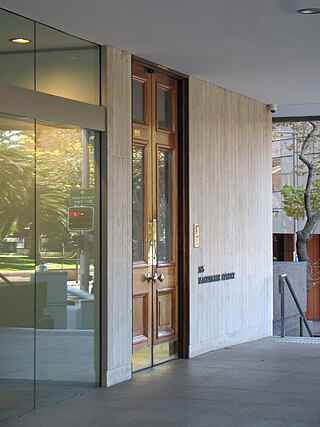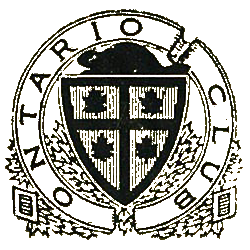
A gentlemen's club is a private social club of a type originally established by old boy networks, typically from Britain's upper classes from the 17th century onwards.

Chelsea Arts Club is a private members' club at 143 Old Church Street in Chelsea, London with a membership of over 4,000, including artists, sculptors, architects, writers, designers, actors, musicians, photographers, and filmmakers. The club was established on 15 November 1890, as a rival to the older Arts Club in Mayfair, on the instigation of the artist James Abbott McNeill Whistler, who had been a member of the older club.

The Tanglin Club is a private members' club in Singapore. The club has 4,000 principal members and reciprocal partnerships with over 130 private clubs. Its memberships begins at $100,000.
The Hong Kong Club is a gentlemen's club in Hong Kong, the first in the city. Opened on 26 May 1846, it is a private business and dining club in the heart of Central, Hong Kong. Its members were among the most influential people in the city, including such personalities as senior government officials, senior local businessmen, the heads of the major trading firms, and many legal and accounting professionals. It was often referred to simply as "The Club". The club's first premises were situated on Queen's Road at the junction with D'Aguilar Street.

The University Club of New York is a private social club at 1 West 54th Street and Fifth Avenue in the Midtown Manhattan neighborhood of New York City. Founded to celebrate the union of social duty and intellectual life, the club was chartered in 1865 for the "promotion of literature and art". The club is not affiliated with any other University Club or college alumni clubs. The club is considered one of the most prestigious in New York City.

The Australian Club is a private club founded in 1838 and located in Sydney at 165 Macquarie Street. Its membership is men-only and it is the oldest gentlemen's club in the southern hemisphere.

The Down Town Association in the City of New York, usually referred to as the Down Town Association or the DTA, for short, is a private club in the Financial District of Manhattan, New York City.
The Alta Club is a private club in downtown Salt Lake City, Utah, named for a local mining district. It was founded in 1883, 13 years before Utah's accession as a state. The Alta Club serves as a forum for business development and social interaction, and offers facilities for dining, social events, business meetings, and health and wellness.

The Metropolitan Club is a private social club on the Upper East Side of Manhattan in New York City, New York. It was founded as a gentlemen's club in March 1891 by a group of wealthy New Yorkers led by the financier John Pierpont Morgan. The clubhouse at Fifth Avenue and 60th Street was designed by McKim, Mead & White and is a New York City designated landmark. The club is controlled by a 25-member board of governors. Initially, only men could become members, though women were given membership privileges in the mid-20th century. Like other Gilded Age social clubs, the Metropolitan Club functioned largely as a meeting place for the wealthy, hosting events such as luncheons, dinners, debutante balls, and business meetings. Over the years, the club's membership has included bankers, industrialists, doctors, lawyers, and CEOs, including several members each from the Goelet, Roosevelt, Vanderbilt, and Whitney families.

Established in 1895, the Erie Yacht Club, is a private club located on the shore of Presque Isle Bay in Erie, Pennsylvania. The purpose of the Erie Yacht Club is to maintain, develop, and enlarge the facilities for yachting and boating, to encourage and develop yachting and other aquatic sports, to promote social recreational activities. To improve yachting and boating facilities at the Erie Yacht Club basin and in the area of the Erie Harbor generally.

The New Cavendish Club was a London private members' club, run along the lines of a traditional gentlemen's club, although it had been founded as a Ladies-only club. It was located at 44-48 Great Cumberland Place in the Marylebone district.

The Athenaeum is a private members' club in London, founded in 1824. It is primarily a club for men and women with intellectual interests, and particularly for those who have attained some distinction in science, engineering, literature or the arts. Humphry Davy and Michael Faraday were the first chairman and secretary and 51 Nobel Laureates have been members.

The Toronto Club is a private members' club in Toronto, Ontario, Canada. Founded on March 20, 1837, it is the oldest private club in Canada, and third oldest in North America.

Philadelphia Club was founded in 1834 and is located at 13th and Walnut Streets in Center City Philadelphia. It is the oldest city club in the United States and one of the oldest gentlemen's clubs. Notable members have included George Meade, Owen Wister, and many members of the Du Pont and Biddle families.

The Boston Club is an exclusive private gentlemen's club in New Orleans, Louisiana, US, founded in 1841 as a place for its white members to congregate and partake in the fashionable card game of Boston. It is the third oldest City Club in the United States, after the Philadelphia Club (1834) and Union Club of the City of New York (1836).

The Calgary Petroleum Club is a private social club in Calgary, Alberta. The club was founded in 1948 as a gentlemen's club catered to executives in the petroleum industry, but since 1989 has been mixed-sex. Membership in the Calgary Petroleum Club has been described as the "pinnacle of social and corporate achievement in a one-industry town."

The Ontario Club was a private club in Toronto, Ontario that existed from 1909 to 2010. The club was founded as a gentlemen's club, but in 1978 became mixed-sex. The Ontario was organised as a home for members of the Liberal Party of Canada, and as such, was the counterpart to the Albany Club, which was for members of the Conservative Party of Canada. From 1912 to 1969, the Ontario Club had a clubhouse on Wellington Street. After it sold the property to the Canadian Imperial Bank of Commerce, from 1972 to 2007, it occupied the top floor of Commerce Court South. In 2011, the Ontario Club merged into the National Club.

The Mount Royal Club is a private social club in Montreal, Quebec. The club was founded as a gentlemen's club in 1899 by a breakaway group from the Saint James's Club, but in 1990 became mixed-sex. In its prime, the Mount Royal was Canada's most prestigious club and was an integral part of Montreal's Golden Square Mile society. During the age when Montreal was the center of commerce in Canada, the club's membership counted many of the country's most powerful executives, bankers, financiers, and industrialists. The Mount Royal's clubhouse on Sherbrooke Street was completed in 1906 and was designed by McKim, Mead & White of New York.
The Quadra Club was a gentlemen's club in Vancouver, British Columbia that existed from 1922 to 1940. Named after Juan Francisco de la Bodega y Quadra, the club was an important social institution in Vancouver during the 1920s and 1930s and counted many of the city's élite among its members. For its first several years, the club occupied the former clubhouse of the Vancouver Club. In 1930 it opened a new clubhouse on Hastings Street where it remained for the duration of its existence. During the Great Depression, the club struggled financially and eventually ceased operations in 1940.

The Terminal City Club is a private social club in Vancouver, British Columbia that has existed since 1899. The club originated in 1892 as the Metropolitan Club, and in 1899 reorganised under its current name. The club was founded as a gentlemen's club, but in 1991, members voted to convert to a mixed-sex membership. The Terminal City is, along with the Vancouver Club, one of the city's two historic social clubs. While traditionally the Vancouver Club catered to the city's old money, the Terminal City was more liberal in its membership policies.



















